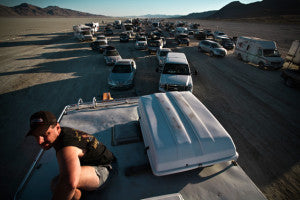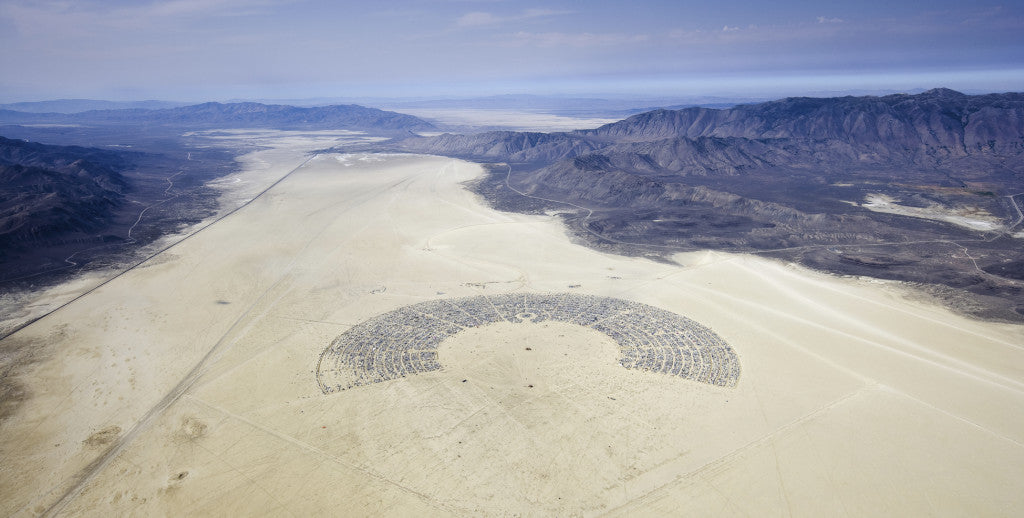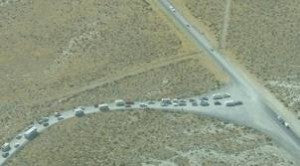
[caption id="attachment_20975" align="alignright" width="300"]

Traffic at Burning Man - via Slate[/caption]
Every year, the week before Labor Day, Black Rock City becomes the
sixth largest city in Nevada. This ephemeral city, which exists solely for the Burning Man arts festival, deals with the same issues of any 70,000-person city: traffic control and traffic jams, water and sanitation, power, health care and law enforcement. It has a large central coffee house, neighborhoods and postal service, many art installations, a wooden temple and loads of bars and entertainment venues, some of which are mobile. And of course it has its namesake: a giant, wooden statue of a man that’s destroyed by fire every year.
Its temporary residents have problems people in no other midsize city face except during a disaster. At the end of the festival, the city must disappear like it never existed. Its residents must provide their own necessities: homes, food, water, sanitation and power. In fact, the only things available to buy are
coffee drinks and ice. Internet and phone service is minimal to nonexistent. The city provides portable toilets but not showers. The nearest supermarket and gas station are nine miles away and jammed. There are no trash cans. All trash – even cigarette butts and wash water – must be stored and removed at the end of the week. Every bit of infrastructure is trucked in on the narrow highway beforehand and trucked out afterward if it’s not deliberately burned during the week. (Even debris from burned installations must be removed and the ground raked over.)
[caption id="attachment_20982" align="aligncenter" width="614"]

Burning Man as seen from above[/caption]
Access to this town 120 miles from Reno, Nev. is possible by a two-lane highway or a temporary airport. Its residents face the extreme weather conditions of the desert: temperatures that range from less than 40 degrees at night to more than 100 degrees during the day, bone-dry, shade-free landscape and windstorms of alkali silt that block the sun and hinder breathing. The alkali dust causes playa foot, a chemical burn on the skin that can cause infection, according to attendee Bee Joli Shah,
writing in Allure.
“The first thing you have to know about Burning Man is it is all about survival, both as a 70,000 person community, and as an individual. That might sound a little scary, okay, it might sound a lot scary,”
wrote former attendee Jennifer Maas for Hollywood Life.
They’ve made it work for 30 years by practicing 10 principles codified in 2004. These principles are helpful in any emergency situation and include Radical Self-reliance, Participation, Communal Effort, Civic Responsibility and Gifting.
“The Black Rock Desert is trying its best to kill you. As ‘
Radical Self-Reliance’ is one of Burning Man’s core principles, it is YOUR responsibility to see to it that it doesn’t.”
the Burning Man web site said.
Check out this
list of required items for Burning Man participants. Notice how closely it resembles lists of supplies for 72-hour kits. Dust masks and goggles are necessary, as is some first aid training. Those are also useful in any disaster situation.
This year, six people were injured, and one was airlifted out, when their theme camp collapsed.
More common injuries include infection, playa foot, heat illness and substance abuse.
A really good guide for Burning Man attendees is also useful for emergency preparedness, telling, among other things, how to set up ad hoc power systems and manage water.
Former attendees recommend wet wipes and vinegar for cleaning, because the vinegar’s acidity can cut the alkalinity of the dust. Vinegar is a good cleaning and preserving agent for an emergency too.
[caption id="attachment_20980" align="alignright" width="300"]

Burning Man Exodus traffic - via Burners[/caption]
Burning Man organizers tell attendees to
fill up with gas in larger towns and make sure their tank is mostly full before they arrive, so they won’t have to fill up during the long wait to leave. This year, attendees had to
wait up to nine hours in their cars after law enforcement stopped traffic to search for a missing 17-year-old girl. Even during normal departure times, called “
Exodus,” people wait six to eight hours just to leave the area, according to event organizers. Organizers have a plan that entails moving groups in hour-plus intervals and turning vehicles off during the wait period.
“Fill up on gas frequently and consider bringing a small gas can. There are very few gas stations on the 90-mile stretch between Fernley and Black Rock City,”
attendee Melanie Curtin wrote for Inc.
The Federal Emergency Management also recommends keeping a car’s gas tank full in case of any emergency evacuation.
A major part of Burning Man is gifting, providing gifts to anyone, without thought of recompense or the size of the gift. Participants are also encouraged to volunteer and work together. In a disaster, people who have the things they need will be able to help others.
Burning Man attendees must be prepared, or they can be turned away,
according to Maas.
“Burning Man encourages the individual to discover, exercise, and rely on his or her inner resources,” the organization’s web site says. “You are responsible for your own survival, safety, comfort, and well-being, and for Leaving No Trace.”
That can be true in any place, in any life event.

 [caption id="attachment_20975" align="alignright" width="300"]
[caption id="attachment_20975" align="alignright" width="300"] Traffic at Burning Man - via Slate[/caption]
Every year, the week before Labor Day, Black Rock City becomes the sixth largest city in Nevada. This ephemeral city, which exists solely for the Burning Man arts festival, deals with the same issues of any 70,000-person city: traffic control and traffic jams, water and sanitation, power, health care and law enforcement. It has a large central coffee house, neighborhoods and postal service, many art installations, a wooden temple and loads of bars and entertainment venues, some of which are mobile. And of course it has its namesake: a giant, wooden statue of a man that’s destroyed by fire every year.
Its temporary residents have problems people in no other midsize city face except during a disaster. At the end of the festival, the city must disappear like it never existed. Its residents must provide their own necessities: homes, food, water, sanitation and power. In fact, the only things available to buy are coffee drinks and ice. Internet and phone service is minimal to nonexistent. The city provides portable toilets but not showers. The nearest supermarket and gas station are nine miles away and jammed. There are no trash cans. All trash – even cigarette butts and wash water – must be stored and removed at the end of the week. Every bit of infrastructure is trucked in on the narrow highway beforehand and trucked out afterward if it’s not deliberately burned during the week. (Even debris from burned installations must be removed and the ground raked over.)
[caption id="attachment_20982" align="aligncenter" width="614"]
Traffic at Burning Man - via Slate[/caption]
Every year, the week before Labor Day, Black Rock City becomes the sixth largest city in Nevada. This ephemeral city, which exists solely for the Burning Man arts festival, deals with the same issues of any 70,000-person city: traffic control and traffic jams, water and sanitation, power, health care and law enforcement. It has a large central coffee house, neighborhoods and postal service, many art installations, a wooden temple and loads of bars and entertainment venues, some of which are mobile. And of course it has its namesake: a giant, wooden statue of a man that’s destroyed by fire every year.
Its temporary residents have problems people in no other midsize city face except during a disaster. At the end of the festival, the city must disappear like it never existed. Its residents must provide their own necessities: homes, food, water, sanitation and power. In fact, the only things available to buy are coffee drinks and ice. Internet and phone service is minimal to nonexistent. The city provides portable toilets but not showers. The nearest supermarket and gas station are nine miles away and jammed. There are no trash cans. All trash – even cigarette butts and wash water – must be stored and removed at the end of the week. Every bit of infrastructure is trucked in on the narrow highway beforehand and trucked out afterward if it’s not deliberately burned during the week. (Even debris from burned installations must be removed and the ground raked over.)
[caption id="attachment_20982" align="aligncenter" width="614"] Burning Man as seen from above[/caption]
Access to this town 120 miles from Reno, Nev. is possible by a two-lane highway or a temporary airport. Its residents face the extreme weather conditions of the desert: temperatures that range from less than 40 degrees at night to more than 100 degrees during the day, bone-dry, shade-free landscape and windstorms of alkali silt that block the sun and hinder breathing. The alkali dust causes playa foot, a chemical burn on the skin that can cause infection, according to attendee Bee Joli Shah, writing in Allure.
“The first thing you have to know about Burning Man is it is all about survival, both as a 70,000 person community, and as an individual. That might sound a little scary, okay, it might sound a lot scary,” wrote former attendee Jennifer Maas for Hollywood Life.
They’ve made it work for 30 years by practicing 10 principles codified in 2004. These principles are helpful in any emergency situation and include Radical Self-reliance, Participation, Communal Effort, Civic Responsibility and Gifting.
“The Black Rock Desert is trying its best to kill you. As ‘Radical Self-Reliance’ is one of Burning Man’s core principles, it is YOUR responsibility to see to it that it doesn’t.” the Burning Man web site said.
Check out this list of required items for Burning Man participants. Notice how closely it resembles lists of supplies for 72-hour kits. Dust masks and goggles are necessary, as is some first aid training. Those are also useful in any disaster situation.
This year, six people were injured, and one was airlifted out, when their theme camp collapsed. More common injuries include infection, playa foot, heat illness and substance abuse.
A really good guide for Burning Man attendees is also useful for emergency preparedness, telling, among other things, how to set up ad hoc power systems and manage water.
Former attendees recommend wet wipes and vinegar for cleaning, because the vinegar’s acidity can cut the alkalinity of the dust. Vinegar is a good cleaning and preserving agent for an emergency too.
[caption id="attachment_20980" align="alignright" width="300"]
Burning Man as seen from above[/caption]
Access to this town 120 miles from Reno, Nev. is possible by a two-lane highway or a temporary airport. Its residents face the extreme weather conditions of the desert: temperatures that range from less than 40 degrees at night to more than 100 degrees during the day, bone-dry, shade-free landscape and windstorms of alkali silt that block the sun and hinder breathing. The alkali dust causes playa foot, a chemical burn on the skin that can cause infection, according to attendee Bee Joli Shah, writing in Allure.
“The first thing you have to know about Burning Man is it is all about survival, both as a 70,000 person community, and as an individual. That might sound a little scary, okay, it might sound a lot scary,” wrote former attendee Jennifer Maas for Hollywood Life.
They’ve made it work for 30 years by practicing 10 principles codified in 2004. These principles are helpful in any emergency situation and include Radical Self-reliance, Participation, Communal Effort, Civic Responsibility and Gifting.
“The Black Rock Desert is trying its best to kill you. As ‘Radical Self-Reliance’ is one of Burning Man’s core principles, it is YOUR responsibility to see to it that it doesn’t.” the Burning Man web site said.
Check out this list of required items for Burning Man participants. Notice how closely it resembles lists of supplies for 72-hour kits. Dust masks and goggles are necessary, as is some first aid training. Those are also useful in any disaster situation.
This year, six people were injured, and one was airlifted out, when their theme camp collapsed. More common injuries include infection, playa foot, heat illness and substance abuse.
A really good guide for Burning Man attendees is also useful for emergency preparedness, telling, among other things, how to set up ad hoc power systems and manage water.
Former attendees recommend wet wipes and vinegar for cleaning, because the vinegar’s acidity can cut the alkalinity of the dust. Vinegar is a good cleaning and preserving agent for an emergency too.
[caption id="attachment_20980" align="alignright" width="300"] Burning Man Exodus traffic - via Burners[/caption]
Burning Man organizers tell attendees to fill up with gas in larger towns and make sure their tank is mostly full before they arrive, so they won’t have to fill up during the long wait to leave. This year, attendees had to wait up to nine hours in their cars after law enforcement stopped traffic to search for a missing 17-year-old girl. Even during normal departure times, called “Exodus,” people wait six to eight hours just to leave the area, according to event organizers. Organizers have a plan that entails moving groups in hour-plus intervals and turning vehicles off during the wait period.
“Fill up on gas frequently and consider bringing a small gas can. There are very few gas stations on the 90-mile stretch between Fernley and Black Rock City,” attendee Melanie Curtin wrote for Inc.
The Federal Emergency Management also recommends keeping a car’s gas tank full in case of any emergency evacuation.
A major part of Burning Man is gifting, providing gifts to anyone, without thought of recompense or the size of the gift. Participants are also encouraged to volunteer and work together. In a disaster, people who have the things they need will be able to help others.
Burning Man attendees must be prepared, or they can be turned away, according to Maas.
“Burning Man encourages the individual to discover, exercise, and rely on his or her inner resources,” the organization’s web site says. “You are responsible for your own survival, safety, comfort, and well-being, and for Leaving No Trace.”
That can be true in any place, in any life event.
Burning Man Exodus traffic - via Burners[/caption]
Burning Man organizers tell attendees to fill up with gas in larger towns and make sure their tank is mostly full before they arrive, so they won’t have to fill up during the long wait to leave. This year, attendees had to wait up to nine hours in their cars after law enforcement stopped traffic to search for a missing 17-year-old girl. Even during normal departure times, called “Exodus,” people wait six to eight hours just to leave the area, according to event organizers. Organizers have a plan that entails moving groups in hour-plus intervals and turning vehicles off during the wait period.
“Fill up on gas frequently and consider bringing a small gas can. There are very few gas stations on the 90-mile stretch between Fernley and Black Rock City,” attendee Melanie Curtin wrote for Inc.
The Federal Emergency Management also recommends keeping a car’s gas tank full in case of any emergency evacuation.
A major part of Burning Man is gifting, providing gifts to anyone, without thought of recompense or the size of the gift. Participants are also encouraged to volunteer and work together. In a disaster, people who have the things they need will be able to help others.
Burning Man attendees must be prepared, or they can be turned away, according to Maas.
“Burning Man encourages the individual to discover, exercise, and rely on his or her inner resources,” the organization’s web site says. “You are responsible for your own survival, safety, comfort, and well-being, and for Leaving No Trace.”
That can be true in any place, in any life event.


